|
|
EFR32xG24 Dev KitSilicon Labs
|
x 1 |

|
Neuton TinyMLNeuton
|
Gesture-based remote control device
Introduction
This project demonstrates a gesture based remote control device using Silabs xG24 Dev Kit. The xG24 development kit could be connected to the PC via Bluetooth as a HID device and using gestures the user can control media stream or slides of the presentation. Based on accelerometer and gyroscope data the Neuton.AI (https://login.neuton.ai/) model could recognize 8 classes of gestures: Swipe Right, Swipe Left, Double Tap, Double Thumb, Rotation Clockwise and Counter clockwise, No Gestures(IDLE) and Unknown Gesture.
Register (https://us02web.zoom.us/webinar/register/1116922062312/WN_8uFdOcMpT3ejRssvLN57og#/registration) for the tinyML Talks, organized by tinyML Foundation, to get a step-by-step tutorial from Neuton.AI and Silicon Labs, about how to create a gesture-based remote control device with an incredibly small total footprint, using the Silicon LabsxG24-DK and Neuton'sUltra-tiny Neural Networks.
To learn more about gestures and how to reproduce them, check out our demo video!
Model specifications
The Neuton.AI Gesture Recognition solution memory footprint:
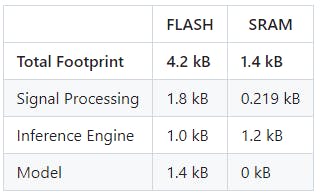
Version 1.1.2
Model Performance:
- 8 classes.
- 58 neurons.
- Holdout Balanced Accuracy: 98.2 %.
- Inference time ( including Signal processing ): 2.3 ms.
Estimated on Cortex-M33, 39MHz, compiled with -Os ARM GNU toolchain.
Hardware overview
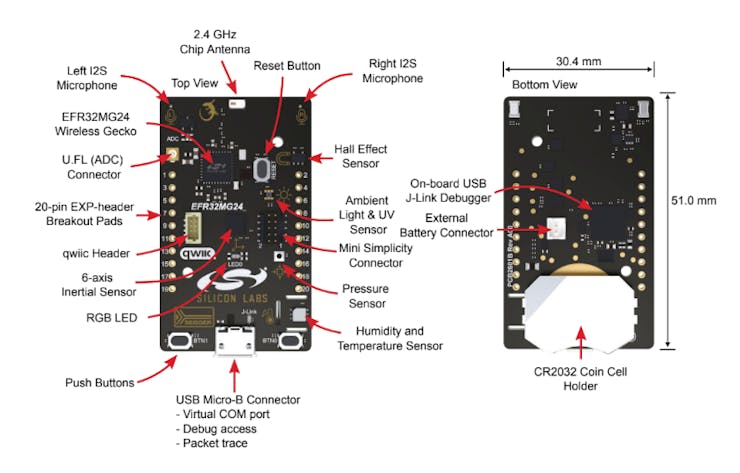
The xG24 Dev Kit is a compact, feature-packed development platform. The development platform supports up to +10dBm output power and includes support for the 20-bit ADC as well as other key features such as the xG24’s AI/ML hardware accelerator. You can find more information on the Silicon Labs xG24 Dev Kit at https://www.silabs.com/development-tools/wireless/efr32xg24-dev-kit
Setup software environment
To set this project up, you will need to install the following software:
- Simplicity Studio 5 (https://www.silabs.com/developers/simplicity-studio)
- Gecko SDK v4.2.2 (https://github.com/SiliconLabs/gecko_sdk)
Setup firmware project
1. Clone this repository: https://github.com/Neuton-tinyML/neuton-silabs-xg24-ble-remotecontrol
2. In the Simplicity Studio, choose File -> Import
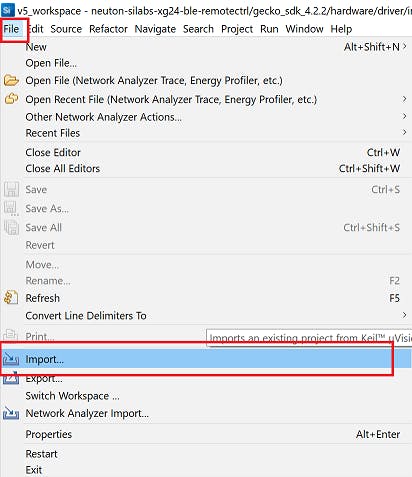
3. Browse to the directory ./neuton-silabs-xg24-ble-remotectrl in the cloned repository and select neuton-silabs-xg24-ble-remotectrl project, and click Next
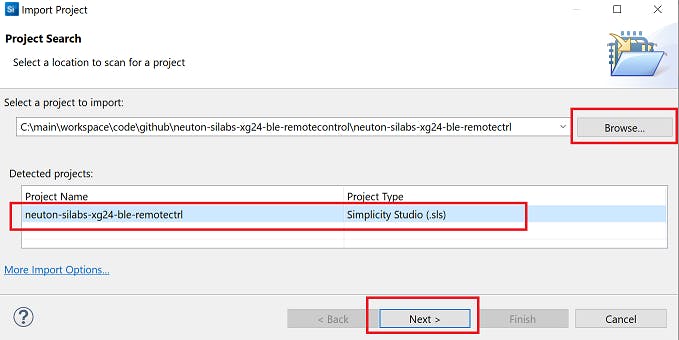
4. On the next page the Build configuration should be automatically detected, just click Next.
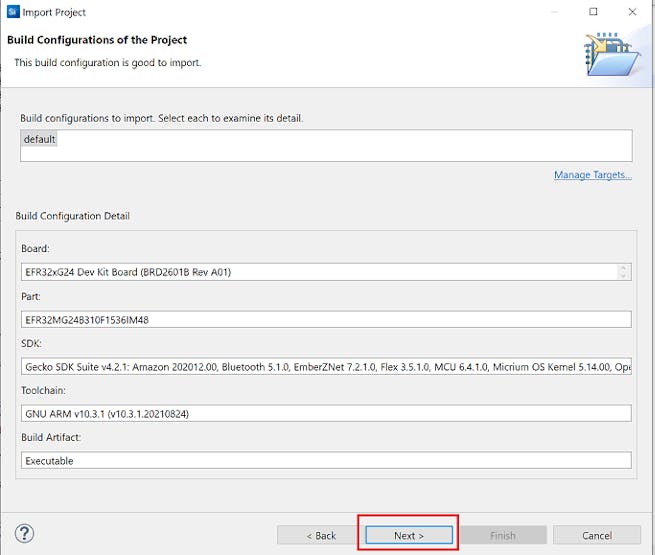
5. Finish importing at the next page, click Finish.

6. Build the project in the Simplicity Studio, right-click on project folder in Project Explorer and choose Build Project option.
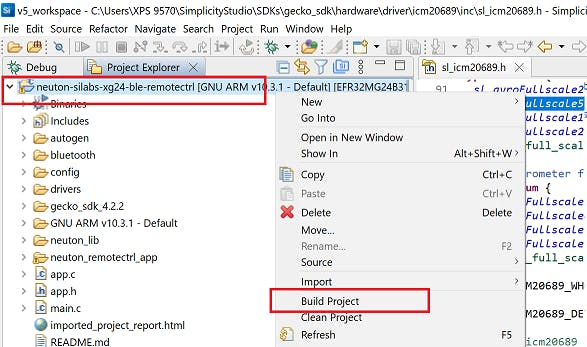
7. Connect xG24 Dev Kit to the PC via Micro-USB cable.
8. Wait for the end of the compilation process and flash the device, right-click on project folder in Project Explorer and choose Debug As -> Silicon Labs ARM Program.
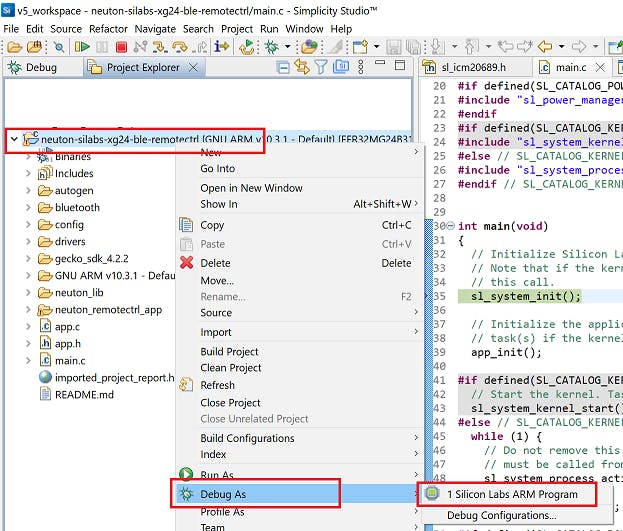
9. Explore the project and Neuton.AI model capabilities!
How the project works
The project has device logs and you can open the Serial Port to see them. The Serial Port(USART) has the following configuration:
Baudrate: 115200
Data: 8-bit
Parity: none
Stop bits: 1-bit
Flow control: none
Once the device is up and running, Bluetooth advertising starts as a HID device and waits for connection request from the PC. In the device logs you should see similar messages:
[I] Bluetooth stack booted: v5.1.0-b144
[I] Bluetooth public device address: E0:79:8D:C6:A2:B9
[I] Started advertising
You can connect devices in the same way as, for example, a regular Bluetooth keyboard.
1. For Windows 10 PC you can go to Settings -> Bluetooth & other devices -> Add Bluetooth or other device.
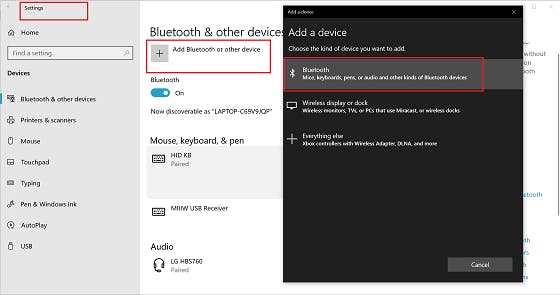
2. The device should appear in Add a device window, choose the device for pairing.
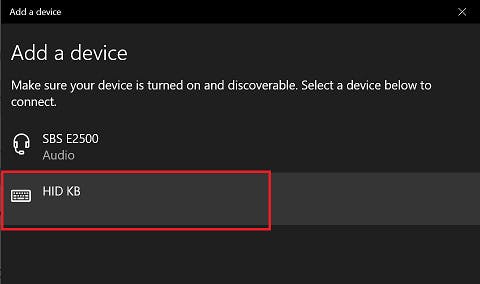
3. After Bluetooth pairing the device should appear in your Mouse, keyboard, & pen section.
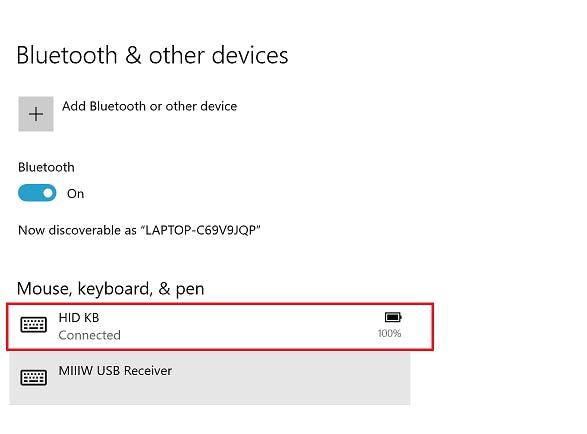
When device is successfully paired via Bluetooth, you should see the following device logs in the Serial port:
[I] Connection opened.
0x020600A0
0x040600A0
[I] Characteristic was attempted changed: 3
[I] Characteristic was attempted changed: 18
[I] Notification enabled.
And the will change the LED indication. The LED0 starts blinking ~5 times per second (5 Hz) instead 1 time per second (1 Hz).
The main functionality of the project is to collect inertial sensor data from the 6-axis IMU sensor and recognize gestures on the device using Neuton.AI model and SDK. The IMU sensor data is collected with 100 Hz of sampling frequency.
The recognized gestures will be printed to the Serial port and sent via Bluetooth as a specific keyboard key.
[I] Predicted class: SWIPE RIGHT, with probability 0.998
[I] BLE Key report was sent
The project has two Keyboard control modes: Presentation Control and Music Control. Depending on the control mode, recognized gestures will be mapped to different keyboard keys:
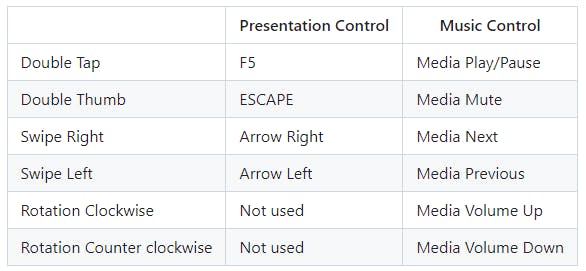
You can switch between control modes by pushing user button BTN0, for different control modes there is a different LED indication. If the device in Presentation Control mode the LED0 will blink RED color, if the device in Music Control mode the LED0 will blink GREEN color.


Enjoy exploring the project!
Gesture-based remote control device
- Comments(0)
- Likes(0)
- 0 USER VOTES
- YOUR VOTE 0.00 0.00
- 1
- 2
- 3
- 4
- 5
- 6
- 7
- 8
- 9
- 10
- 1
- 2
- 3
- 4
- 5
- 6
- 7
- 8
- 9
- 10
- 1
- 2
- 3
- 4
- 5
- 6
- 7
- 8
- 9
- 10
- 1
- 2
- 3
- 4
- 5
- 6
- 7
- 8
- 9
- 10
 More by AlexMiller112
More by AlexMiller112
-
 Gesture-based remote control device
IntroductionThis project demonstrates a gesture based remote control device using Silabs xG24 Dev Ki...
Gesture-based remote control device
IntroductionThis project demonstrates a gesture based remote control device using Silabs xG24 Dev Ki...
-
 Ultra-Tiny Solution of Daily Activities Recognition
IntroDespite the incredible variety of wearable devices today, most of the AI features come down to ...
Ultra-Tiny Solution of Daily Activities Recognition
IntroDespite the incredible variety of wearable devices today, most of the AI features come down to ...
-
 TinyML experiment on building a weather station
StoryLately, I’ve been really passionate about the field of TinyML, actively researching how to enab...
TinyML experiment on building a weather station
StoryLately, I’ve been really passionate about the field of TinyML, actively researching how to enab...
-
 Tiny ML Air Writing Recognition with Nicla Sense ME
StoryLess than half a year ago, a new Arduino’s board, Nicla Sense ME (Motion & Environment), hi...
Tiny ML Air Writing Recognition with Nicla Sense ME
StoryLess than half a year ago, a new Arduino’s board, Nicla Sense ME (Motion & Environment), hi...
-
 Making Famous Magic Wand 33x Faster
IntroThis case is a remake of a well-known “magic wand” experiment. Last year, Pete Warden, the famo...
Making Famous Magic Wand 33x Faster
IntroThis case is a remake of a well-known “magic wand” experiment. Last year, Pete Warden, the famo...
-
 Real-time Food Quality Prediction
With each passing year, the issue of food waste becomes more acute for the environment. A recent Foo...
Real-time Food Quality Prediction
With each passing year, the issue of food waste becomes more acute for the environment. A recent Foo...
-
 TinyML Monitoring Air Quality on 8-bit Microcontroller
StoryI’d like to share my experiment on how to easily create your own tiny machine learning model an...
TinyML Monitoring Air Quality on 8-bit Microcontroller
StoryI’d like to share my experiment on how to easily create your own tiny machine learning model an...
-
 Detecting Unstable Electrical Grid with TinyML
IntroductionElectricity is the heart of modern social and economic development. More and more countr...
Detecting Unstable Electrical Grid with TinyML
IntroductionElectricity is the heart of modern social and economic development. More and more countr...
-
 Tabular Data VS Computer Vision: Detecting Room Occupancy
StoryToday, room occupancy detection is widely used in public places as a way to provide safety, man...
Tabular Data VS Computer Vision: Detecting Room Occupancy
StoryToday, room occupancy detection is widely used in public places as a way to provide safety, man...
-
 Tiny ML for Big Hearts on an 8-bit Microcontroller
StoryIn the course of the pandemic, the interest in creating more innovative medical devices has run...
Tiny ML for Big Hearts on an 8-bit Microcontroller
StoryIn the course of the pandemic, the interest in creating more innovative medical devices has run...
-
-
AEL-2011 Power Supply Module
525 0 2 -
AEL-2011 50W Power Amplifier
485 0 2 -
-
-
Custom Mechanical Keyboard
693 0 0 -
Tester for Touch Screen Digitizer without using microcontroller
330 2 2 -
Audio reactive glow LED wristband/bracelet with NFC / RFID-Tags
310 0 1 -
-
-









































